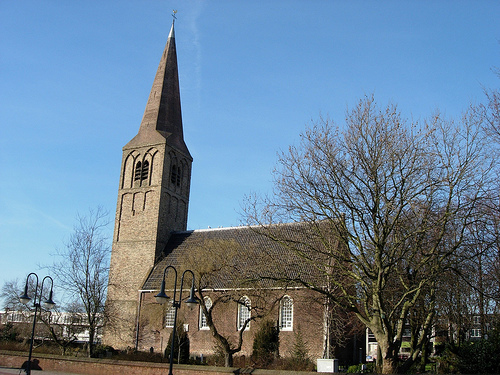

Location: Heemskerk
The Dorpskerk van Heemskerk is a church building in the center of the North Holland town of Heemskerk. The church is located at Kerkplein 1, and belongs to the Protestant Municipality of Heemskerk.
The church is first mentioned in 1063. What it looked like is unknown. Over the centuries, a church of tuff, a gray volcanic stone from the Eifel, was built on the site of the current one. The tower was built in the 13th century from the so-called monastery mop, which are baked large stones that were used to build monasteries. The church was dedicated to Saint Laurentius. The substructure of the tower belongs to the Romanesque architectural style. The superstructure belongs to the Flemish art Gothic. The Gothic-style part was probably built in the first half of the fifteenth century.
The ringing bell has a year of 1464. This bell was made by Steven
Butendiic, a bell founder from Utrecht. Like the church, the bell was
dedicated to St. Lawrence. The clock had a social warning function. In
case of storm, fire or other danger, the population was called to help
or warned by ringing the bell.
During the Second World War, the
clock was taken from the tower to be taken to Germany. The ship to
transport the clock ran aground near Urk and sank. After the war the
bell could be identified and in 1946 it was returned to the church
intact.
During the siege of Alkmaar in 1573, the Spaniards demolished
everything that was flammable from the church. Only the tower remained
intact. In the meantime the reform had taken place. In 1585 the spire
collapsed due to a lightning strike. The tower was rebuilt in a
different type of stone, which is still visible today.
After the
retreat of the Spanish soldiers, reconstruction by the Protestants
began. It will be a hall church without choir in Gothic style. The
church was rebuilt in 1628. A year later, the church is completely
finished. The rooster dates from 1728. Since 1798, the tower has been
owned by the municipality. A vestry was built in the back of the church
in 1868.
In 1970-1973 the tower and the church were restored. The
tower is designated as a national monument and is illuminated by
floodlights at night. Since 1967, both the church and the tower have
been registered as a national monument in the monument register.
The noble families of Heemskerk already had their own crypts in the
two chapels of the church from the beginning of the fourteenth century.
These chapels no longer exist. The last remains were demolished in 1800.
In the Dorpskerk, the preservation of old gravestones has preserved
tangible memories of a long period of burial in the church. This was
banned in 1829. The cemetery contains the obelisk of Heemskerk, a
16th-century funerary monument for the father of the painter Maarten van
Heemskerck.
The cemetery has been used as a municipal cemetery
since the reform. On May 3, 1987, a monument was unveiled at the
cemetery at the Dorpskerk, close to the British military graves. A
British Lancaster with seven pilots on board crashed on December 16,
1943 near the Kruisberg in the North Holland Dune Reserve. Pupils from
seven Heemskerk schools have each adopted a grave. Twice a year, the war
graves receive a floral tribute. This happens on May 4 National
Remembrance Day and on December 16.
Now that Reformed and Calvinists have merged into the Protestant Church of the Netherlands (PKN), Sunday services are usually held in the more spacious Morgensterkerk in Heemskerk for practical reasons.
The Gothic west tower slowly but surely crumbled. After this was discovered in 2012, there were scaffolding and a shelter to protect visitors while entering. The restoration, commissioned by the municipality of Heemskerk, was completed in 2013.